Is anybody else even regularly doing a Substack Newsletter anymore? This feels very familiar to me, like when I did my Marvel.com blog years ago, and the others who were working on similar gave up the ghost after twenty-five entries or so, while I powered on and did more than 300 of them. What does it mean? Well, that I’m either dedicated or foolish, or possibly both.
This past week, in a very strong showing as compared to the recent past, I received One Hundred Questions from readers of this feature. And that’s great, it’s nice to see that people are interested and feel like they have a place to get their queries answered (even if they sometimes don’t like the answers that they get.) But I am going to ask everybody who has been enjoying getting one of these each Sunday morning to head over to The Hero Initiative and donate a few bucks to comic book creators who have fallen upon hard times.
And I think it’d be especially good if those self-described rumor-mongers who have been turning the contents of this feature into a string of profit-generating clickbait articles might do the same. Only seems fair, doesn’t it?
Now obviously, I’m not about to answer One Hundred Questions in this space. Fortunately, certain topics generated a lot of the same interest. Still, this is going to be a long one. So let’s get started.
Callie
Tom, I gotta know, what is the line where sales stops being the driving factor? For instance, back in the days of the CCA, there were times, such as the infamous Hobgoblin addiction arc, where someone would decide that they were willing to publish a major comic book without the CCA seal of approval, knowing full well it could lead to far worse sales because they felt it was a public good to tell that story for all the people it might help. A similar thing happened when the CCA was dropped by marvel, I believe it was an issue of X-Force having a gay kiss.
Both those cases ended up working out fine, and I believe the ASM issue actually sold incredibly well and led to the CCA changing their restrictions on depictions of drugs, but what would happen if that wasn't the case in a future similar situation? The CCA is defunct now but there are certainly things that some people who read comics just wouldn't be on board with. For instance, if you were presented with certain, unassailable evidence that having a character in a comic book of a specific minority group would lower sales significantly, that it simply wasn't what readers wanted to see, would you change a comic book featuring a character of that type to not include that character? Would the many people who that comic book could help be outweighed by the need for sales?
I always have this worry, when I see a business like this where sales are as high up there in importance as the story being told in any given run, that it could lead to people prioritizing sales over morals, over doing something that actually makes a difference. It's one of the reasons I've started drifting towards indie comics, especially ones by people like Kieron Gillen who have such powerful and amazing representations of diversity in their books to an extent unseen at the big two. I've especially noticed that despite marvel's earlier victories in that field that these days, DC is providing far more representation in a less tokenized form.
I’m going to be pretty direct here, Callie. While there are certainly other missions that the Marvel Comics Group takes on, other objectives that we would like to achieve, other good that we want to do, sales are the primary objective always. Without sales, we don’t get to do any of that other stuff, and your favorite comics are discontinued. So there’s always going to be a balancing act. But in most instances, sales are going to trump other considerations. As they should! If you can’t get your message to anybody, what good is screaming into the sky? We’re a business, and a part of staying in business is remaining profitable. And that means that every project we do has to hit a certain margin of profitability in order for us to keep the lights on.
Alison Cabot
Tom, in a telepathic battle between Xavier and Emma, who do you think would win? Many fans disagree on who is more powerful. What is your opinion?
If you’re talking about purely put-the-on-a-scale measurement, Alison, then I would give the edge to Xavier. But like in any sports match, that isn’t the be-all and end-all on who might win in a fight in a certain situation. End of the day, story trumps stats.
Levi
When you say something like “this is how the character was for the first decade of his existence” you seem to implying that the original conceit of a character is more important than the FORTY YEARS of stories that have happened since then.
What makes the initial design of a character more important than the way they’ve been written for the majority of their existence? What makes old comics that the majority of your audience hasn’t read more important than recent comics that your audience has actually read?
Nothing does, Levi. But you’re talking about storytelling choices, and we make those decisions in the present, after careful consideration.
JV
I was recently re-reading the latest Uncanny X-Men masterwork edition (with the Inferno crossover) and in the intro Chris Claremont states he (and the other writers) did the best they could with the convoluted continuity of Jean coming back at the time (he implies he wanted her to stay dead).
If you could travel back in time - what do you think the best creative decision would have been? Keep Jean alive (pre Shooter mandated death) with Dark Phoenix as a recurring foil? Not bringing Jean back as X-Factor and letting her stay dead? Having Madelyne as Jean reborn?
The Death of Phoenix is a seminal story but in hindsight I kind of like the original plan of keeping her alive better (considering she came back again and again).
If it was me, JV, I would never have brought back Jean Grey after the Death of Phoenix. i think that her return in particular opened up the floodgates and led us to the current state of play in which death is at best a minor inconvenience, an enforced vacation from the books for a couple of years until you inevitably come back. Jean being resurrected changed the rules. Now, on the flipside of that, if Jean had remained dead since 1980, she wouldn’t have been in a lot of stories that made the present day coterie of fans love her. She’d be a bit more like Gwen Stacy in that regard (and even there, with Spider-Gwen as a going concern, most readers of today conflate those characters anyway.) And so maybe there’d have been some potential that wasn’t realized. But I genuinely think that the return of Jean in the mid-1980s was a top-three narrative mistake in the history of the company, so given a choice, I definitely wouldn’t have done it.
David Harper
Tom, the vast majority of fans want Stilt-Man to be in every Marvel comic. When are you all going to give the people what they want?
Stilt-Man IS in every Marvel comic, David. You just have to look up.
Jordan L
Interesting that the X-Men column you reposted from 2003 ends with you saying that we wouldn’t want you editing the X-titles. Funny how things change. I’m curious to hear how your perspective on what you wrote about in that column has changed in the past two decades. I’m skeptical that we’ll be seeing Illyana’s fateful battle with a cinder block in the pages of Jed’s X-Men for example.
Things may have changed, Jordan, or they may not. Certainly there have already been all sorts of X-Fans who have expressed their dismay that I’m taking over the line. And there’s nothing that guarantees that what I and my team are about to do will change their minds on that score. Now, I haven’t read that piece in a long time, so I don’t entirely remember what I said in it. But as I tell our editors, Understand the Mission and Accept the Mission are two separate parts of the equation. And we’re well past that second one on the X-MEN material—we’re well into the third area, Accomplish the Mission. And the key thing, I think, is that I can get a sense as to what the current audience likes about those characters and titles as well as a sense as to what the overall audience has liked about those characters and titles over the years. So we’ll see how it all goes.
Zach Rabiroff
Thinking about some of the blood and thunder going on here and elsewhere about the shift in the X-line, I wonder if it has something to do with the way comics tend to handle status quo changes in the modern era. Back in the 70's or 80's, big shifts happened, but they tended to happen organically: a new writer would begin where the last one ended, and spend a few issues getting things set up the way they wanted them. And that, perhaps, made for a more gentle way of easing readers into the new order of things.
Nowadays, the changes tend to have much firmer lines in the sand: Krakoa ends one month, and From the Ashes begins the next, and never the twain shall meet. That makes things much more digestible in collected editions, but it also must be jarring and upsetting to those attached to the previous era. So my question, Tom, is: do you see any of this as a problem? And do you think there's any kind of approach that helps to address it?
I’ll be honest, Zach, I think the reason this shift in the X-Line is so much more traumatic than the norm is twofold. First, it represents the end to a status quo of recent duration that a fair number of people were really enjoying. So it’s not simply a change of editor or writer, but almost a change of premise. And sure, that change of premise would have happened regardless of whether the editorial offices changed as well. But by talking about that change-over here, I put a bit of a spotlight on the whole process. I don’t know that, for the most part, anybody really cares who is editing X-MEN or any of the rest of our books. I’ve met few people who pick up books based on their editor. But in this instance, this second point has fused together with the first point—and that associates the trauma of the change with this switchover. But honestly, as people will see in the coming weeks, the changeover here is about as smooth a handoff as you could imagine. Literally in the pages of the same comic book, one era ends and the next begins a literal panel later. So if you’re a reader who isn’t paying any attention to editorial credits, it’s not going to seem especially jarring to you. There’ll definitely be a shift, but it’ll be story-based rather than personnel based.
Dewey
Do you know why the 60s Captain America series is generally referred to as Vol. 1 rather than the 40s series? Is it as simple as the 40s book technically being from Timely instead of Marvel?
Effectively yes, Dewey. The 40s series was technically called CAPTAIN AMERICA COMICS. But even beyond that, i think in the 1960s nobody was looking at these new books as straight up continuations of the older books. That’s why SUB-MARINER is a vol. 1 as well.
Nick
As a child of the 90’s I was over the moon to see the Andy Kubert variant cover for Uncanny, I was wondering how involved in getting Andy back you were? And if it signifies him coming back to marvel full time? Because that would be rad 👍🏻
I wasn’t at all involved in getting Andy Kubert to work on this piece, Nick. It was all done by Rickey Purdin and his team. And I believe it isn’t a new piece at all, but rather something that Andy had from back in the day. Either way, I haven’t worked with Andy for almost 25 years, but I’d be happy to do so again if circumstances permitted.
Julian Eme
Many comments this week allude to the hypothetical Scott-Logan-Jean relationship, and in one of your answers you mention that only one scene is what would support that it was an open relationship over five years.
What this comment has led me to think about is the small number of everyday scenes that exist in today's Marvel comics. I'm a reader who grew up reading in the '70s and '80s, and I really miss the everyday element in superheroes. Because at that time we knew Peter Parker's apartment inside out or what pizza he liked; and there were plenty of character treatment scenes in the Avengers and X-Men mansions or in the Baxter Building. In current times, I have the impression, probably subjective, that that element of everyday life has been lost a lot, that the Marvel characters are more iconic, but less close and identifiable in those aspects.
Recently, I was taking a look at my favorite scenes by Pepe Larraz, an artist who creates spectacular fight scenes, but the ones that stuck in my mind were not any of those, but small moments of characters talking in an everyday environment. I was thinking about a scene that is quite a few years old now: the conversation between Cyclops and the vampire Storm in a cafeteria, in X-Termination. If I remember it so vividly it is precisely because of the magical nature of these types of situations, and that for me they summarize the essence of the Marvel Universe: the way in which the fabulous and fantastic is introduced into the real world. When I remember what hooked me on X-Men, I remember a lot of that. Kitty and Doug playing video games, Peter, Kurt and Logan at a bar, Storm swimming in the Forge pool, or the usual baseball games in the mansion's courtyard. I really miss seeing those types of situations in comics in a more common way. I hope we have many of those in the new run that now begins, because that is also part of the X-Men lore.
We’re definitely looking to do more of that manner of scene, Julian, depending on the series and the preferences of the creative team. One of the things I definitely wanted to get back to, for good or ill, was the X-Men interacting with regular people out in the world rather than segregating themselves with only their own kind in Krakoa.
Joe West
I noticed in the solicit for Stephanie Phillips’ Phoenix #1 that it would guest star Nova, but as of now he’s still in a coma from Pestilence’s arrow in X-Men Red and hasn’t been healed/woken up yet. Will him being back in action be explained in that issue or before then? Just curious.
I’m almost certain that it won’t be explained in PHOENIX #1, Joe. Presumably, he healed up over time.
Ralf Haring
The vast majority of fans want you to know that they know what the vast majority of fans want.
And whatever it is, Ralf, they want it now!
Han
Could be possible to have a solo of Summer's family: Scott's son, Ruyby of daughter of Scott and Emma and Scott's brothers and father. I'd like to see how their connection is explored in a book. I don't include Rachel since I think that she is like Hope. She only daughter of Jean and Phoenix is the father
It isn’t impossible that we could do a book such as the one you’re describing, Han—though the specificity with which you’re describing it makes it less likely that we’ll ever be able to give you precisely what you’re looking for.
Alan J. Porter
I’ll be conducting a workshop on Customer Outcome Focused Storytelling for one of my corporate consulting clients in a couple of weeks. I’d like to include the “Four Cs” outline you mentioned recently, with suitable citation of course. Would that be OK with you?
Absolutely, Alan. Of course.
Cian McDarby
There’s a class of books where it feels like it just kinda is a name that gets a premise. For example, Thunderbolts, DC’s Outsiders, the Defenders and special note to the X-Factor, where I’ve counted about 10 different premises the book has taken. Do you have any special thoughts on this genre of book? What about their relationship with the so called “Fake books”? Does the lack of a set team and premise mean the books have an easier time keeping an understandable, constant role and concept? Or does those same factors actually hinder the book in finding that “place” in the universe? Or is there really no connection from your experience and it just go on a book, team, editor basis?
I tend to disagree with you about THUNDERBOLTS, Cian, which shouldn’t be much of a surprise considering I was involved with bringing that series into the world. But there are definitely titles where you need to stretch and expand the concept over the years in order to make the series viable. And that isn’t limited to these books—I would argue that, for example, AVENGERS #16 with its massive roster-change represents just as much of a shifting of gears. But that one worked, and so today it’s just seen as a part of the book. So while there have been a bunch of different approaches to THUNDERBOLTS, they almost always (barring the short-lived wrestling sequence) have been about villains behaving like heroes, or at least like protagonists. As long as your concept has some aspect of that approach, it can probably work as THUNDERBOLTS.
CG
After reading your most recent newsletter it really got me thinking about another topic that goes through its ups and downs every couple months and I think you did note somewhere else that the divide within the fandom was noticed by the editorial office. And that is the Psylocke conundrum. There are those that feel Betsy owns the codename and the butterfly because she got those from her original creator and before the body swap shenanigans. HoXPoX brought in newer fans that feel that it all belongs to Kwannon because the character of Psylocke became popular in her Asian body.
We know business wise keeping the iconic Jim Lee look and code name with an actual Asian character makes sense but was it necessary to do that when comic book readers (I hope) are not that inept and because we do have both caucasian characters Kitty Pryde and Elektra that were allowed to function in the same capacity but are not Asian; but it was taken away from Betsy for reasons. We could have gotten both Psylocke and Revanche popular established IP.
I think this is a situation analogous to the Jean Grey one from a while back, CG. By which I mean that there is a lot of frankly confusing backstory to Kwannon and Betsy Braddock, to the point where they’re literally difficult to describe to people. But rather than try to “fix” any of that stuff or retcon it or whatever (which is very much what got us to this point), I think the only thing to do from here is to go forward. And that means further defining who Kwannon is as Psylocke and who Betsy is as Captain Britain (or whatever she might become in days to come).
Mercury Seastar
You mentioned before having a "grand unified field theory" about Scott and Jean's relationship, one that you'd peel back like layers of an onion across several stories. Can we expect that to play out in X-Men and Phoenix or is this something that we can expect further down the line? And any hints or elaboration on what you might have meant by this theory?
I think that’s more of a long term things, Mercury, though I’m sure that you’ll see aspects play out in the various comics that Jean and Scott are in, since I’ll want them to be in line with my way of thinking. And eventually, assuming that there are creators among our team that are interested in running with that ball, we may eventually get to it as a story element. Or we may not—X-MEN functioned for years with a lot of its characters’ backstories hidden away, and that mystery didn’t hurt anything, it drove interest among the audience. So it’s really going to depend on where I think we might be able to get the most juice.
Jason
I've seen on Xwitter that Swifties believe the announcement of the Dazzler comic is proof their favorite singer will be in Deadpool & Wolverine. Do you have any plans for your safety if what they want doesn't happen? Witness Protection, plastic surgery, a new hat?
I have no fear of the Swifties, Jason, for I have lived among them, going back to a time when it was possible to affordably get seats like this.
Bos
Many of the artists working for Big 2 comics come from non english speaking countries. I’m personally always glad to see the name of my fellow spaniards in the titles page. And it just might be a lack of knowledge on my part, but there aren’t as many writers from non english speaking countries ( Torunn Grønbekk notwithstanding). Why do you think that is?
Also, do you recall any examples of a comic panel or page changing significantly as a result of a translation miscommunication?
I think this has everything to do with fluency in English, Bos. An artist may be able to get by if he can use either translation software or some associate who speaks the language even if he or she doesn’t. But to write actual dialogue requires a level of wordsmithing that is difficult for non-native speakers to reach, though it isn’t impossible. As a good example, when Carlos Pacheco began plotting and penciling FANTASTIC FOUR, he did so with his friend, science fiction author Rafael Marin. Marin is a very intelligent man, but his final copy was clunky and often felt unnatural—it required a lot of work to polish every issue. This is why Joe Quesada prevailed upon Jeph Loeb to dialogue the series, as Jeph is adept at writing copy in English.
In terms of translation miscommunication, the one that I remember was back when Ed Brubaker was writing UNCANNY X-MEN. The team was in space, and Warpath was depressed and sad about something, and the scene called for him to be moping around the deck. But when the artwork for the page came in, Warpath had a water bucket and a mop and he was cleaning the deck—the artist had mistranslated “moping” as “mopping”. But it all got fixed before anything saw print.
Leigh Hunt
As mentioned previously I'm coming back to the X-books to give the new era a try. Other than the odd occasion (eg start of Hickman's run) I've not really been invested in the X-Men much in the last 20 years. Will there be things to help returning readers like me? For example recap pages or headshot title pages that say who is who? Any mutant introduced this century is likely to be totally new to me! Or will all the explanations needed be within the story in a "every book is somebody's first book" kind of way?
All of the above, Leigh. We’re definitely going to have recap pages, and they’ll include a hopefully helpful roster of the known characters within that issue. And every writer on my team knows that I’m a bit of a pitbull when it comes to naming characters and “Claremonting” their powers, so we’ll be doing that within the stories as well. Our intention is to create a line of X-MEN titles that are easy access, in response to the often-expressed opinion that the line is hard for a newcomer to get into. So let us know what works and what doesn’t, because this will be a constantly-evolving process as we go.
Dr. Doom
In short: "What I liked was when it was unpredictable. But then it became UNPREDICTABLE, and I didn't like that!"
I'm not poking fun at Tom in particular; and yes, you can like some elements of stories and dislike others. But after lauding Claremont's "where is he going next?" and then citing it as the reason he dropped off strikes me as how many/most/all of us who like comics get with these things that we love.
I think the actual difference that you’re talking about is way simpler than what you describe here, Doom: I liked it when John Byrne was co-plotting and controlling a good portion of the narrative, and I liked the book less after he departed and other people with different outlooks took up those duties in his place.
Jeff Ryan
Is a two color book like Black, White, and Blood appreciably cheaper to print for Marvel? Or do the four-color ads negate the cost savings? (Relatedly, do darker comics get charged for using more ink?)
All of the examples cost the same amount, Jeff. The Black, White & Blood books, for example, use red, which is a two-ink operation: a mixture of magenta and yellow. So the printing there is still four color/full color, it’s just which inks are being used on each page that varies. Same thing with darker books.
Ben Morse
so many times over the past 20+ years I’ve seen launches of Thunderbolts couched as “Marvel’s Suicide Squad,” which I find reductive as they’re both great concepts, particularly the initial volumes, that happen to star villains but are otherwise quite distinctive. I thought I’d ask if there was any Suicide Squad baked into the original T-Bolts, and, if not, why has this become such common shorthand over the years?
Not so much into the initial launch, Ben, apart from the fact that it was a series that was going to be featuring villains. But I do think Suicide Squad is one of the best and most elemental concepts for a shared universe series that has been created in years, and we definitely borrowed from it over the years as THUNDERBOLTS ran for a longer and longer period.
thirdlightly
I have a question about Cyclops. Will have another second mutation? I ask this since I always question myself why he is the leader mutant when Jean and Storm are more powerful and intelligent than him. Jean has alway saved the mutant. And Storm has showed us to be better leader than Cyclops. Why is he the leader of mutants instead of Jean?- Will Cyclops power evolve in order to understand his position as a mutant leader?
What, you mean something like this, Third?
Leadership isn’t about power level, ultimately.
Rob Secundus
This is interesting, as I believe you've talked before about how there was an entire line of X-Men comics not only conceived and being constructed but being *advertised* (The "New X-Men") before that was cancelled and you/ your team came on board. The current X-line also seems to be rushing to a conclusion, every page quickly wrapping up a plot thread, as if those issues did *not* have a long lead time. so I guess my question is-- is "exceptionally long lead time" just speaking relatively here? What's the typical lead time from pitch to publish of a marvel comic? And how far out do you typically have a line planned ahead? And, if you have the time, how have these times shifted over the course of your career? I imagine that throughout the 4-issue ongoing era, lead times must have shrunk somewhat, and it would have been difficult to plan too far ahead, as opposed to the writing-for-the-trade era, when indefinite ongoings were still feasible.
You’ve got a bunch of information off the mark here, Rob. There weren’t any post-Krakoa titles in production at the time my team took over. At most, there were a bunch of ideas, but nothing that had been ratified and moved ahead with. And my editors and I started in August, the first of that month, so it was ten months that the previous crew had to wrap up all of their storylines however they wanted to. That’s a very long lead time. By comparison, the current X-Office is already working on titles you don’t even know about for December and January and even a little bit beyond. There isn’t one specific timeline for the creation of a new book. As I think I spoke about here before, a couple of years ago my crew pulled together an entire 10-page Free Comic Book Day DARK AGES story package-to-plate in just two weeks. That’s the other extreme. Most typically, you’re usually about three or four months ahead of what is on the stands.
Sosa
Where does Madelyne Pryor sit now, editorially? Is she still the purview of the X-Office or is she a Spider-Man character now? Or does it not matter?
Madelyne Pryor is 100% an X-Office character, Sosa. But that doesn’t mean that she can’t show up in AMAZING SPIDER-MAN or wherever if the story requires it, just like all of the MU characters.
Isaac kelly
Manga sells very well in the states and is largely black and white. Meanwhile, the American direct market can't seem to sell a black and white comic to save its life. Usagi Yojimbo, Finder, Bone, Scott Pilgrim, old UK comics all switched to color or colorized, presumably because black and white just doesn't sell. Why do you think that is?
I think the constant comparisons between manga and American comics don’t really get into the essential differences between the two. First off, the material is all paid for, apart from any translation and lettering. So right there, it’s a different animal. That and the black and white printing allows you to put out a volume with a relatively low A & E overhead. And the audience has come to understand and accept that manga is typically in black and white—just as most of them have come to accept that real manga is read from right-to-left. But I think, for most American readers, if they had the option to purchase the same material in color, they would take it. The expectation is different here.
Dammit Damian
I'm sure that comes from years and years of letters pages, but how did you develop your thick skin? Any advice on the rest of us as to develop our own thick skin and handle all the "negative" comments as well as you do?
This is going to sound just a little bit dismissive, Damian, and I’m sorry about that. But the real answer is realizing that nothing that happens online really matters. There are creators and editors who never engage with social media at all, and whose books sell fine. Others of us choose to engage with this audience. And it’s a fan audience, a hardcore audience, and that means that each individual communicator is going to be more dedicated to their position and feelings than the average. But it also means that those folks are no different from the majority who simply buy their comics, read them and enjoy them. So the threats and the vitriol and the calls for editors to be fired or disciplined or whatever—it’s all theater, it’s a tempest in a teapot. Once you realize that, it’s impossible to take a lot of that seriously. Like anyone, every once in a while some random comment will get under my skin. But for the most part, I’m here for the people who generally like what we’ve been doing and who want to interact and have a more full experience. And that means sometimes answering questions and talking down fans who may be upset about something. But as long as we all treat one another with basic human respect, that’s all good. I don’t need you to agree with me, but I do need you to be civil, to myself and to your fellow fans.
Zenon Silva
is the wolverine ongoing going to take place parallel to uncanny x-men?
Just as it does now, Zenon, yes.
Matt Singer
So glad you’re enjoying Opposable Thumbs. As a comics reader for decades, it made me really happy to see this.
I saw that you wrote a Spider-Man book as well, Matt. May have to seek that out when I get a minute. And OPPOSABLE THUMBS was a nice piece of work about a show that I watched with some regularity for at least a decade, but which I hadn’t much thought about (apart from reading Ebert’s autobiography back when it came out.) So I enjoyed it.
Behind the Curtain
.I’m reproducing this cover image just because of how nice it is.
This is one of the first covers that Tom Palmer would have inked over Gene Colan, a penciler who was notoriously difficult to interpret, given how often his work would be depicted in assorted shades of grey. Here, Palmer expertly employs about three different values of zip-a-tone, plastic acetate sheets with a dotscreen printed on them that would adhere to the artwork and provide you with a printable greytone. Different artists, usually the younger and more progressive guys, began playing with these in the mid-1960s, but Tom, having come from the world of advertising, was already something of a master with them.
Pimp My Wednesday
Vacation time is over, and so from here on in, expect to find a decent number of new releases in this section every week. Beginning with…
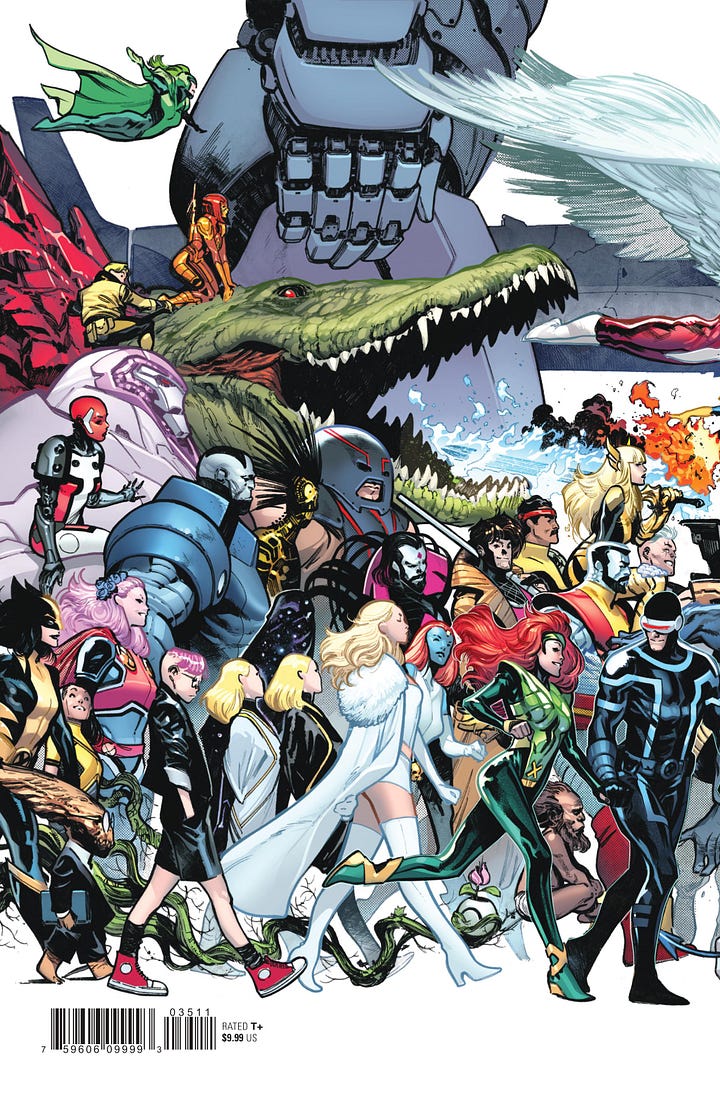
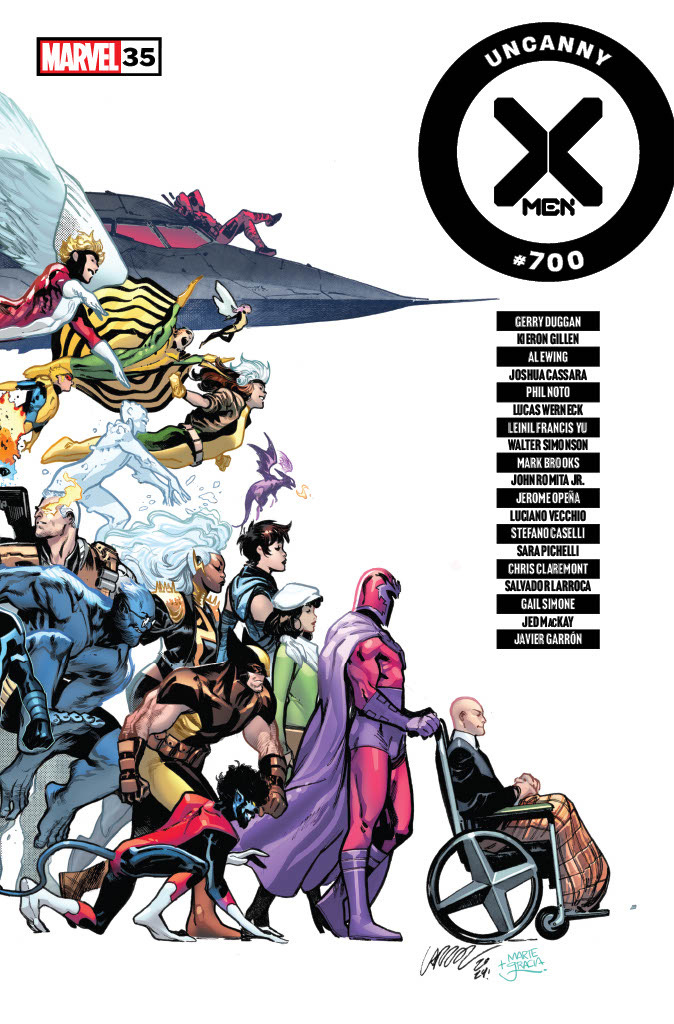
The big one! X-MEN #35, which is also known as UNCANNY X-MEN #700. This is the final issue of the Krakoan Era, and editor Jordan D White and his crew pulled out all the stops to give you a 60-page finale with all of the bells and whistles—and with contributions not only from the three mainstay writers, Al Ewing, Gerry Duggan and Kieron Gillen, but a full fleet of artists whose work graced the Krakoan period all coming back to do a bit as well. There’s also an all-new story from Chris Claremont and Salvador Larroca dealing with the recent revelations concerning Nightcrawler’s parentage. It’s really nice to see Chris be able to get into some of these ideas after having sat on them for so much time. But then finally, the moment you’ve all feared is finally upon us. Me and my guys, in particular Gail Simone, Jed MacKay and Javier Garron, produced the 10-page epilogue that begins to usher in what is to come. We pick up literally right where the final Krakoa story leaves off and then set the table for where a bunch of our characters will be when we pick them up again. It’s a tiny little taste, and aperitif, but we’re looking forward to people being able to see it and react to it. Also, I’ve got a little challenge for the readers of this newsletter. Gail and Jed co-wrote this 10-pager, but each one wrote their own pages. So I’d like to see if anybody can figure out who did what, or whether we disguised our tracks well enough that it all feels like it came from the same hand. I’ll be looking for your guesses in the comments section
Also out this week is Assistant Editor Martin Biro’s second issue of the BLOOD HUNT tie-in anthology series, BLOOD HUNTERS. It features a Kate Bishop story by Ann Nocenti and David Baldeon, a Hulk tale by Kaare Andrews and Alex Lins, and the second part of the running Dagger and Elsa Bloodstone story by Erica Schultz and Bernard Chang.
And over in the digital space, we’ll be debuting the new iteration of what had been X-MEN UNLIMITED on the MARVEL UNLIMITED app, and what is now X-MEN: FROM THE ASHES. It’s being edited by Darren Shan and Noah Sharma, and its stories will represent a key bridge between the Krakoa era and all that is to follow. Regular writer Alex Paknadel starts things off with a Cyclops and Phoenix story set on the evening before Jean has to set off for her duties among the stars. Will there be any thruple action here? All I can say is that what happens in UNLIMITED stays in UNLIMITED. The stories that we’re going to be doing in this venue are going to be essential parts of the full mutant picture, so if you’ve been holding out, now’s your chance to get on board!
A Comic Book On Sale 85 Years Ago Today, June 2, 1939
ACTION COMICS #14 is noteworthy in that it’s the issue of the title that came out concurrent with SUPERMAN #1, and the first issue of the series that began to run an inset image of the Man of Steel even on covers that he wasn’t a part of. It’s sort of crazy to think that, even having discovered what a powerhouse character Superman was, the editors of ACTION COMICS weren’t confident with giving him the cover spot regularly. That would soon change. The other big thing that happens in this issue is that the Man of Tomorrow crosses swords once again with his first recurring super villain, albeit one that wasn’t much of a threat to him in a physical sense. This was the Ultra-Humanite, a wheelchair-bound scientist whose brain power and inventive genius were enough to give Superman a run for his money. Possibly this was in response to a request from writer Jerry Siegel’s publishers about giving the hero a harder time—even after only 14 appearances, it was already clear that pretty much nothing could even slow the Man of Steel down. So the story begins with a simple Subway racket, but it turns out the Ultra is the brains behind it, and just as he had done in the previous issue, he challenges his foe with mighty super-scientific devices, then gets away at the end. He was clearly something of a prototype for Luthor, who wouldn’t come along for a while yet. This issue also introduced the SUPERMEN OF AMERICA, the long-running Superman fan club that was active well into the1960s. For ten cents—the price of a comic book—you would receive a membership certificate, a button, and a copy of Superman’s secret code, with which you could decipher messages from the Man of Tomorrow that would be printed in each issue of ACTION COMICS. It was very much a standard membership premium package for a fan club of that era, but it brought in hundreds of thousands of dime. The rest of the issue featured a variety of disposable strips, the most memorable of which was probably Fred Guardineer’s Zatara the Magician. But Zatara was pretty much just Mandrake the Magician with the serial numbers filed off, and no matter how hard the DC editors tried to push him—making him the cover feature on this issue for example—he just wasn’t any different from all of the other comic book magicians who were already crowding the stands. Every anthology comic seemed to have one. The money here, the sales juggernaut, was clearly Superman.
A Comic I Worked On That Came Out On This Date
HOUSE OF M #1 came out on June 2, 2005 and was the first line-wide crossover that Marvel had done in about five years. Departed Marvel Publisher Bill Jemas didn’t have any interest in such things, but his replacement Dan Buckley, having worked at Marvel during the 1990s, was well acquainted with their sales power. But it didn’t start off as a big Event at all. After AVENGERS DISASSEMBLED had run its course, we had another of our regular Creative Retreats where we talked about stories and projects for the next couple of months. For whatever reason, in that Retreat there was a bit of a discussion about our big villains, with a desire to do some projects that would spotlight them. Ed Brubaker was convinced to do a Doctor Doom history called BOOKS OF DOOM, and it was a short hop from there to thinking about a similar Magneto-based project. As Magneto had taken off with the Scarlet Witch at the end of AVENGERS DISASSEMBLED, there was a definite interest in following up on that situation. We had the name HOUSE OF MAGNUS or HOUSE OF M before we even really had the story.
But there was a little bit of a problem. Both the X-Office, under editor Mike Marts, and the Avengers office, headed by me, wanted to be the ones to work up HOUSE OF M. And we argued over it for a week or two. Finally, one morning, I had an epiphany and went to Marts to tell him that he could do HOUSE OF M, and that I didn’t want to fight about it any longer. Of course, that’s not how things worked out in the end.
You see, the recently-launched ASTONISHING X-MEN was already having scheduling difficulties. I forget which show Joss Whedon was working on at that point. DOLLHOUSE maybe? FIREFLY? Anyway, whatever it was kept him busy enough that he wasn’t able to steadily get John Cassaday scripts. But ASTONISHING X-MEN was a part of our publishing budget for the year, so something had to be done. The solve, as it turned out, was to do HOUSE OF M as a big Event series, and to brand it as NEW AVENGERS/ASTONISHING X-MEN. That way, the revenue derived from it would make up for any shortfall from ASTONISHING not coming out regularly. Joe Quesada did most of the legwork on this, approaching Brian Bendis and asking him to take this on, and agreeing to have Olivier Coipel draw the project.
And at that point, I looked up and realized that this was going to be a NEW AVENGERS project written by my NEW AVENGERS writer and drawn by an artist I had brought over to draw AVENGERS. And so I went back over to Mike, and told him that I had no problem ceding the project to him when it was just going to be a Magneto-centric series. But given these circumstances, I was going to be the one to do it. In this case, Joe Q agreed with me, and so HOUSE OF M became my project, the first in a long string of Event series that I would work on. (I had previously done MAXIMUM SECURITY, but that had been half a decade earlier. Still, it gave me some needed experience.)
HOUSE OF M was created as an 8-issue series that would ship twice a month, but by the middle of it, Coipel was dragging in the manner of John Cassaday, and so the decision was made to spread it out further. It was selling really well, and definitely more than covering ASTONISHING X-MEN’s nut.
The ending was conceived relatively late in the game. Brian had put forward from the start that we could use the transformation of the world into the House of M reality and back to correct any aspects of our continuity that we may have wanted to. I don’t know whether he had Hawkeye’s resurrection in mind the whole time or not—in every outline, the idea was that Hawkeye would be alive in the world of M, but would fight to restore the natural order even though he’d wind up dead again in it. It was only at the last minute that Brian turned in the final script that indicated that Hawkeye was still alive in our world. It had only been maybe a year since we killed him off, but I had no complaint with his return.
The bigger move here was in correcting what Joe saw as a mistake that was permitted to happen during the Grant Morrison run on NEW X-MEN. In that series, grant had increased the number of mutants in the world by at least a factor of ten, the end result of which was a feeling that mutantkind was no longer a minority, but a majority. Wanting to scale things back, it was decided that the Scarlet Witch would utter “No More Mutants” and an enormous swath of mutants would lose their powers in the restored world. I don’t remember who came up with the idea for The 198, but that quickly became the number of mutants still remaining in the world, most of whom would be gathered up at Xavier’s in what was essentially a reservation. I had thought that there were too many mutants as well, but I thought that 198 was too few, but that wound up being the status quo of the X-Books for several years, so it all worked out.
Wolverine also got all of his lost memories back, another thing that Brian dropped into a script without checking with the X-Office and which I had to untangle after the fact a little bit. But this led to the WOLVERINE: ORIGINS series and the introduction of Daken, so that was a plus.
The Deathlok Chronicles
Once again, we begin with some thoughts from DEATHLOK co-writer Gregory Wright:
Gregory Wright
For reasons I can never quite understand...Butch Guice...who was and is a very good friend, never seemed to properly complete ANY project we started on. Not true..he brilliantly pencilled and inked a WONDER MAN story Dwayne and I wrote for SOLO AVENGERS, which I how I managed to get him interested in doing Deathlok in the first place...but every other project I did with him as a writer or colorist...somehow never got properly finished...lol. I remember BEGGING you to hire Butch, and I begged him to do the annual as well, so we can share the blame for that...I forget if he originally planned to ink it or if Jimmy Palmioti was always on board to do it. It never ever occurred to me that Denys would feel somewhat insulted or less because we utilized Guice. I guess I always thought Denys knew just how spectacular his work was. That makes me feel bad. I'm not sure if you even know about this bit of fun...Butch called me to tell me he was going to beg off doing the Annual mid way through it. Either he didn't like the story and what he was drawing, or had some other more interesting or lucrative gig...but I was furious and bit my tongue to beg him to complete it. I even said he could just do breakdowns...(What's this, Greg going behind his editor's back and making promises he has no business doing? I hope we were in communication about this...but I was a bit...controlling) He did agree to finish it off, but it was obvious that he was just doing the bare minimum. And YES...I never. ever had an artist turn in pages so randomly and cause me to have to rethink the entire story because some of it was indeed just MISSING, and all this stuff I wrote that I thought would be fun for him to draw was just outlines and silhouettes...sigh...this was where I started to realize that I needed to write FULL FULL SCRIPTS. And even THAT might not be enough as we might be learning... It was really disappointing that this didn't quite go as planned. When I created Timestream I didn't realize how annoying his speech pattern was going to be...and how much like YODA it would up reading like. My GOAL was to do a stand alone issue that introduced a new character in a fun environment. I think it was actually a REQUIREMENT of the annuals that year as well. It also stung that Denys' art, done entirely by HIM, was so awesome in that fun story Dwayne wrote and I really wished I had gotten color it. I didn't color the Annual cover, so I'm glad I can get no blame for the color Quesada didn't like.
That last bit is interesting. If asked, I would have sworn that you colored that Annual cover. So now I wonder who did. Joe Rosas maybe? He had been doing work for our Special projects office and I liked his stuff.
And now we come to the next big, devastating mistake that I made editing DEATHLOK. this one is likely responsible for sinking the series, even though it an for another 18 issue or so. As I’ve spoken about, Greg and I were on the hunt for a new artist to take over the series from Denys Cowan. We had come close once or twice, then had our selections snatched away by the offer of a better assignment elsewhere. This was an era in which everything was selling well, and companies were cropping up all over the place and launching new super hero universes. Accordingly, there was a bit of an arms race for talent, and a lot of people entered the field who wouldn’t have been able to get arrested only a few year later, after the bubble burst. It was also a time where new artists were showing up on books and within an issue or two becoming red-hot superstars. This was the dream of every young editor, I think, to discover the next Jim Lee or Todd McFarlane in the samples pile and establish a relationship with them before they became a massive draw. I’m only explaining this to provide context for what I did here, not in any way to excuse it. But I still wasn’t very experienced, and despite my good intentions, I wasn’t yet very smart when it came to publishing.
So at some point, we found our guy. His name was Walter McDaniel, and he was young. Younger than me, that’s for sure. He had sent in a bunch of samples that looked really nice, very modern and slick with some of that modern artist flavor to them. I think I was the one who came across them, and I showed them to Greg, who also thought they looked good. So with that, I called up Walter and offered him the book.
Let me repeat that again for those who missed it the first time: without even trying this young kid out under battlefield conditions, I offered him a regular book at Marvel, based entirely on his samples. What an idiot!
This was exceedingly stupid, obviously so. But in my youth, i thought that this was the way that it was done, and I didn’t want to lose another prospective artist like we’d done in the past. So I just went for it.
This led to a whole cavalcade of problems. Dwayne was certainly not happy that I was going to give Denys the boot, though he didn’t really fight it all that much. Possibly he was thinking that relatively soon, he and Denys were going to have to step away anyway, to launch their MILESTONE line of titles. I don’t know. But he rolled withe the punch. One person who didn’t roll with it, as Greg spoke about a week or two ago, was inker Mike Manley. He had thought that he was the heir apparent to the title, and so my telling him that somebody else was going to be doing it was like kicking him in the ribs. He also didn’t like the look of the artwork at all. So he quit on the spot. I’m honestly not certain that I’ve so much as spoken with Manley in all the years since, which is a shame, as he was a really lovely fellow.
But this meant that we needed an inker for the book, and I turned to Jimmy Palmiotti. I liked Jim’s work and he and I were on good terms, so it seemed like a relatively easy fix. And it was, until it wasn’t, but that’s a few issues down the line.
I don’t remember exactly why Walter’s first issue wound up being this one-off INFINITY WAR tie-in written by Dwayne. It may have had to do with the fact that Greg’s next story, CYBERWAR, was going to run for 5 issues rather than 4, and that the middle one, #19, was going to be getting an enhanced cover—a thing that tended to spike sales in those days bigtime. Doing a tie-in with INFINITY WAR, despite the fact that I felt that the project was weaker than the prior INFINITY GAUNTLET and a bit repetitive as well, proved to be the right move. Sales on this issue popped right back up over 100,000 copies again, though they just stayed there for the one issue. Still, I had given the widest possible audience a look at the book’s new artistic look.
Which should have been a good thing. But really wasn’t.
You see, Walter had never drawn a full comic book before, and certainly not under real world conditions. I don’t know how much time he had spent on his samples, but it had to have been a lot more time than he was going to get on his actual pages. And that was apparent almost instantly. Walter came in with his first boards—and my heart sank a little bit. He was trying, but he was raw as anything, and cheating stuff all over the place. Clearly, he had never been called upon to draw a car. Now today, the obvious thing to do in this situation would be to cut bait, even if this one issue had to be completed by Walter because the schedule was still so tight. But having gone through the saga of hiring him, and having shot Denys, I refused to do the sensible thing. I thought that we could work with Walter, that he would improve over time and get better. He was definitely enthusiastic. But he was still a kid, and he didn’t have the sort of work ethic necessary at this point. Several years later, he produced a really good run on DEADPOOL for editor Matt Idelson. But here, he was clearly in over his head. And I absolutely refused to throw him a life raft—or myself, or the book as well.
The smart play here would have been to try him out on this one issue and then evaluate from there. But I wasn’t smart, not yet. And so my troubles continued.
Monofocus
As a sort of palate cleanser after last night’s dark and disappointing episode of DOCTOR WHO, my wife and I buoyed our spirits by taking in Ron Howard’s new documentary on Disney+, JIM HENSON: IDEA MAN. I’ve read and watched a lot about Jim over the years—the Muppets were a big part of my world growing up, as they were every kid’s in the 1970s and 1980s. But this was a well-presented encapsulation of Henson’s life and career, and included a bunch of footage that I’d never seen before. The tragedy of Jim’s death at the crazy-young age of 53 is still difficult to believe, and to cope with. If anything , it feels very much of a piece with the young death of my friend, Marvel’s guiding light Mark Gruenwald, who was similarly puckish and creative and who also passed away unexpectedly at a criminally early age.
I also got a copy of Danny Wallace’s new book SOMEBODY TOLD ME this week, but I haven’t had the time to crack it yet. Wallace was introduced to me by Greatest Assistant Gregg Schigiel many years ago through his book YES MAN (which was made into a middling movie—don’t judge the work by that) in which Wallace spends an entire month saying yes to absolutely every question that is put to him, and thus getting into scrapes and adventures. My sense of SOMEBODY TOLD ME from its jacket is that it’s in the same genre of real-world adventure as it deals with the spread of misinformation across Social Media. I’m quite looking for ward to it.
Posted at TomBrevoort.com
Yesterday, I wrote about this SUPERHERO GIFT PACK that I was given one Christmas.
Five years ago, I wrote about the Narrative Techniques of Jack Kirby
And ten years ago, I reposted this 15 year old piece about WATCHMEN
Nothing else to say at this point, I’m pretty well fading. So see you next time!
Hat’s All, Folks!
Tom B






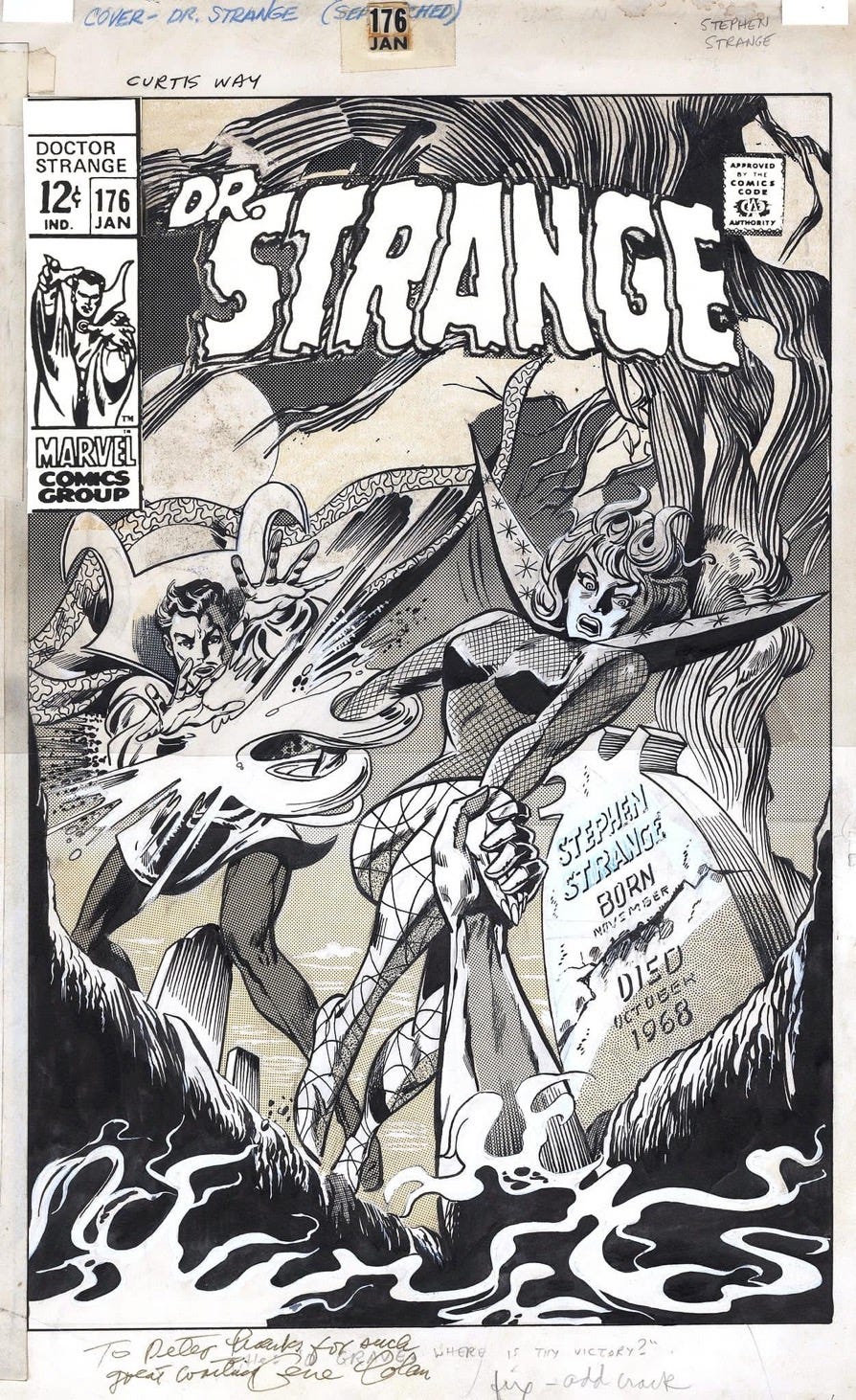
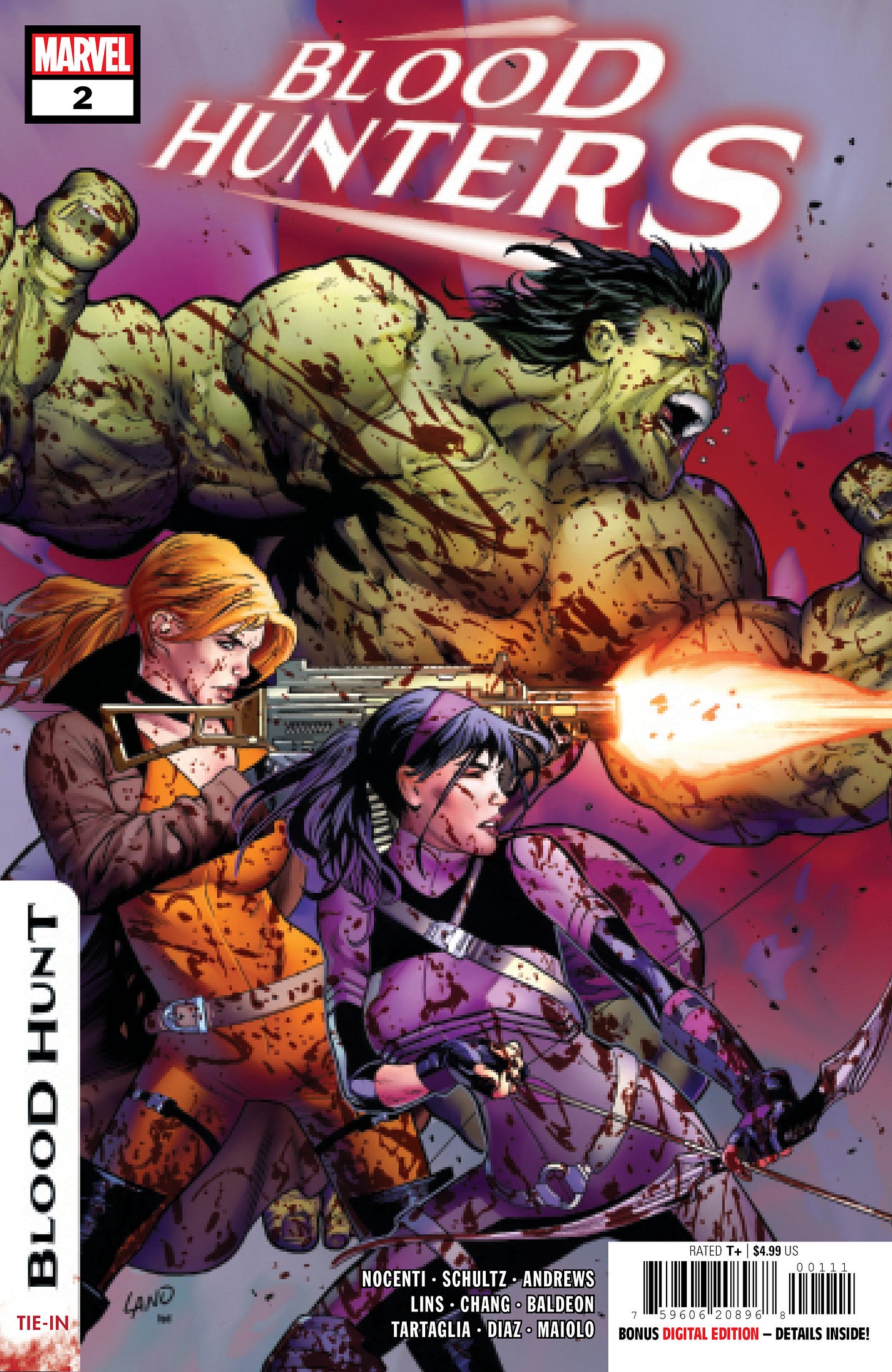
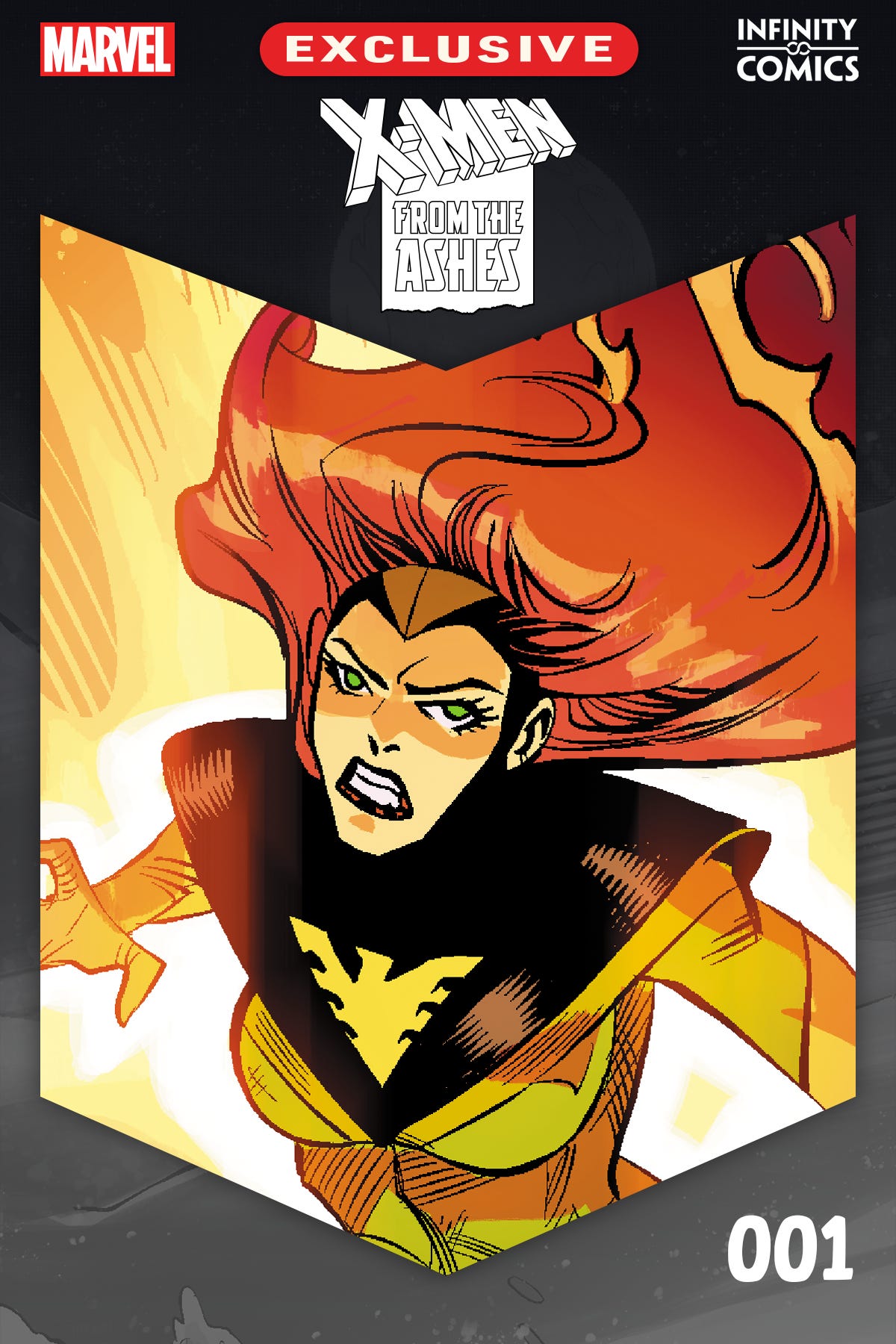
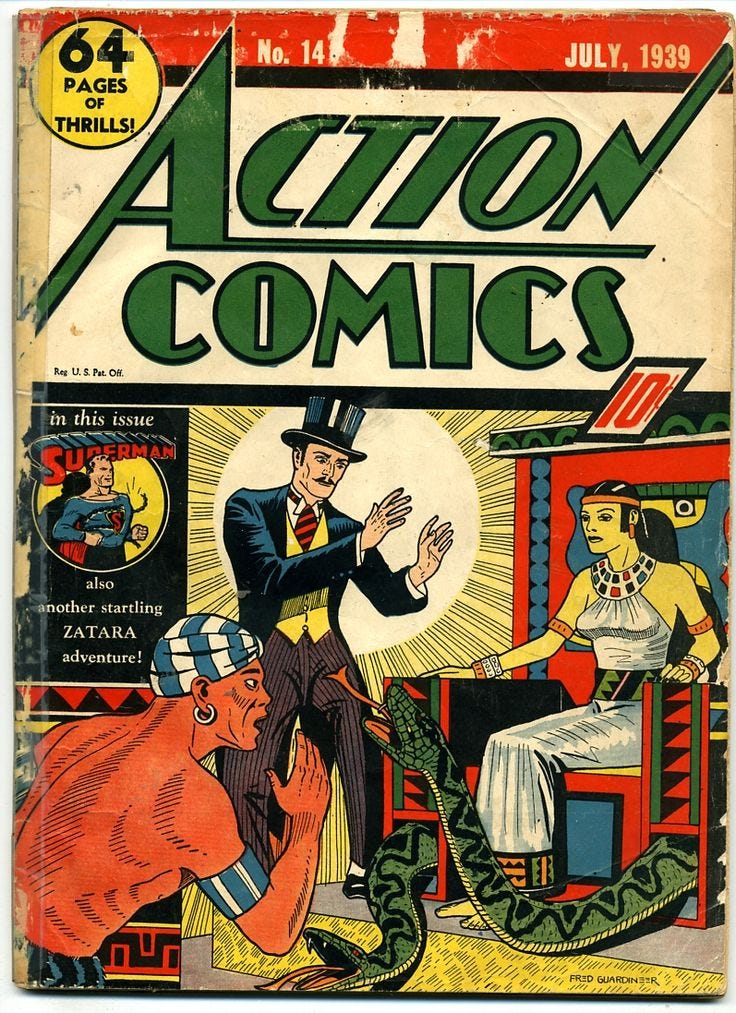
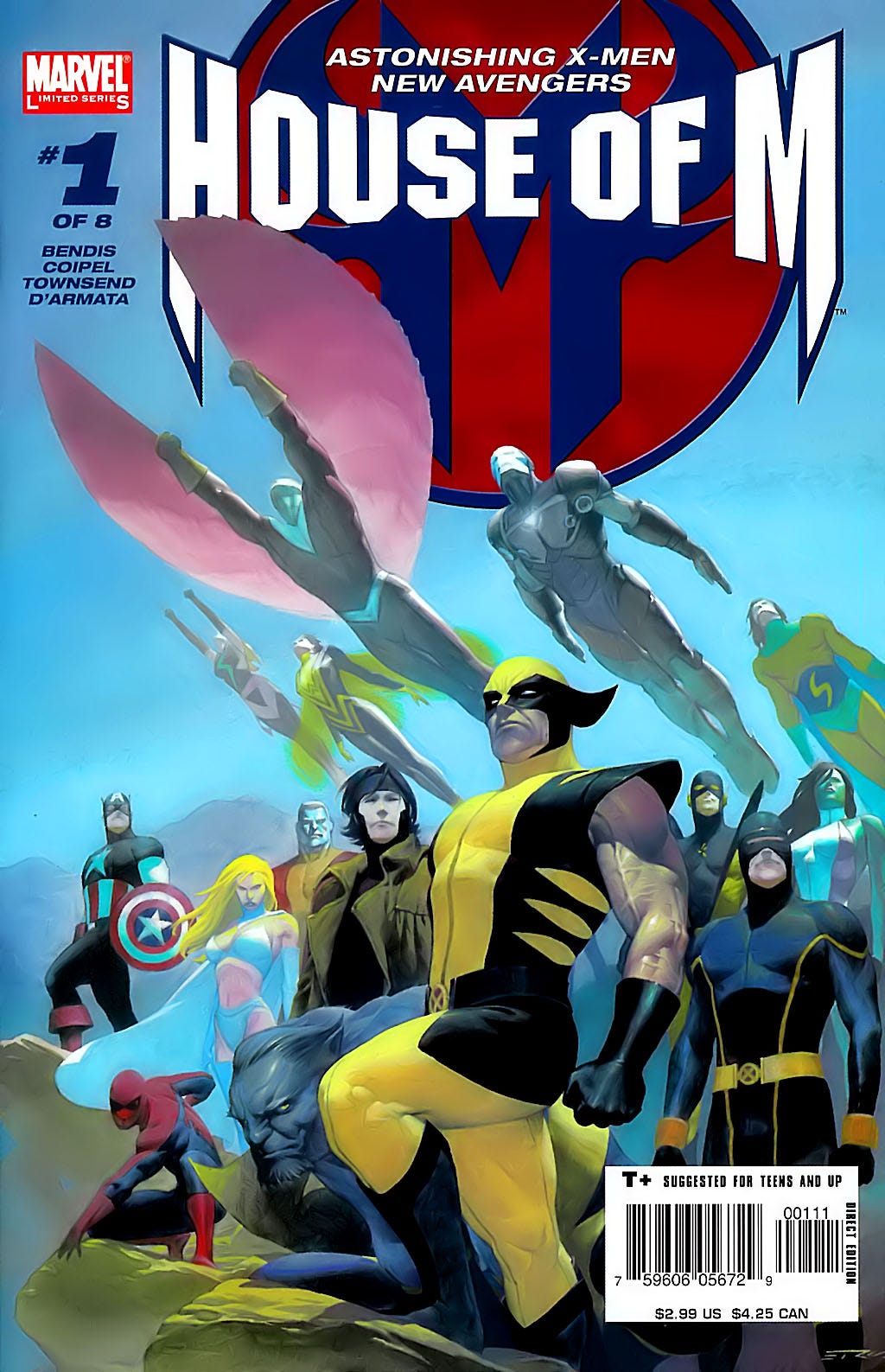
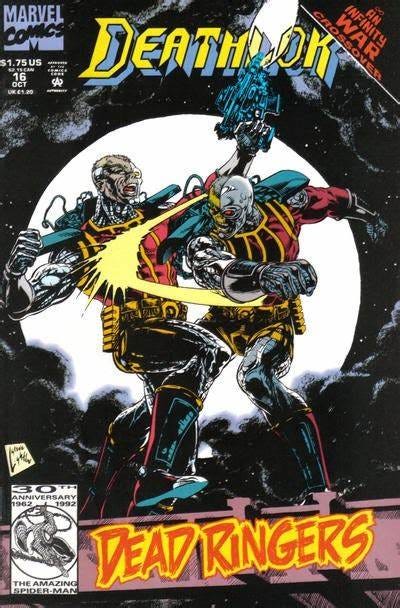
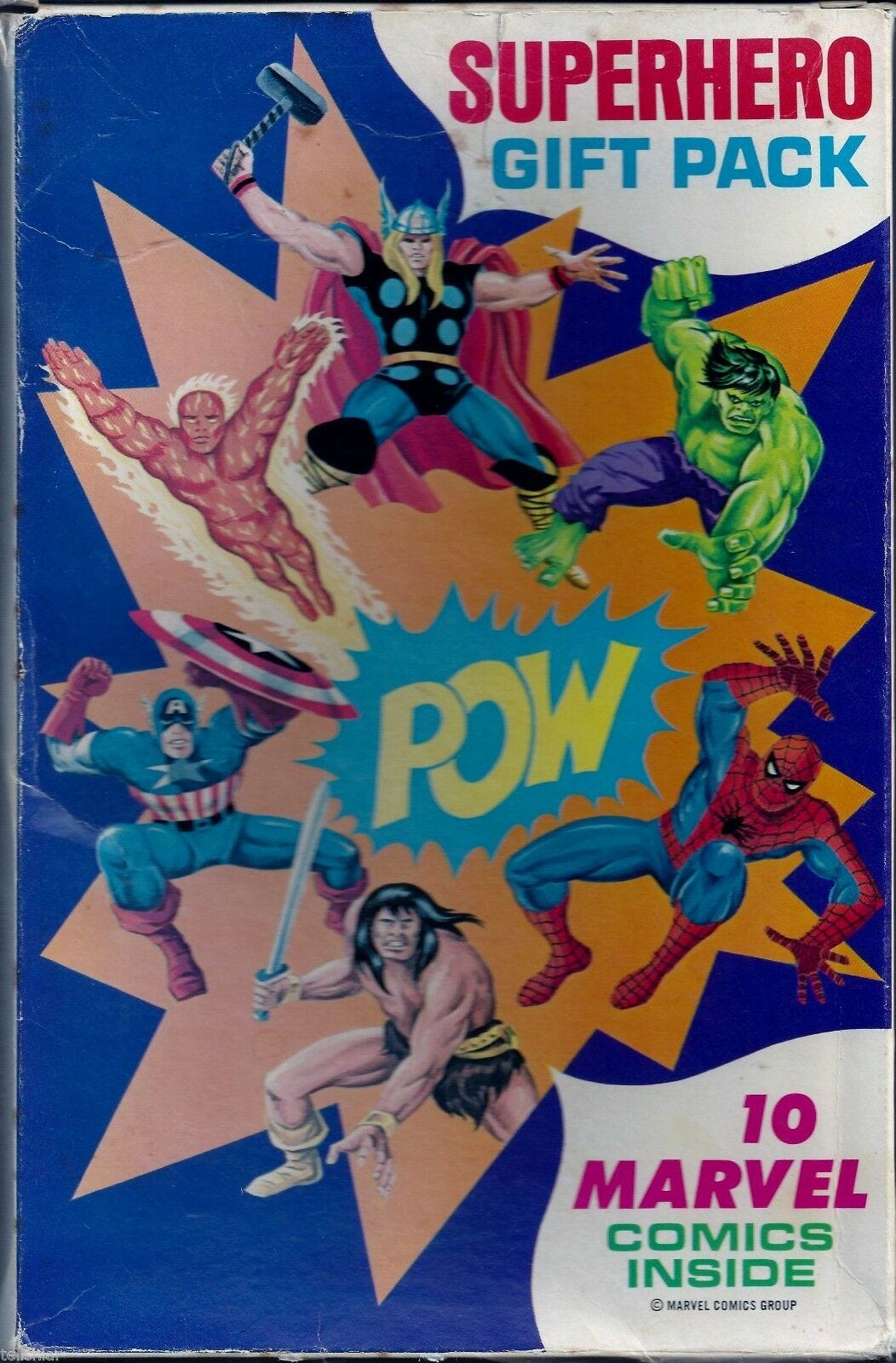
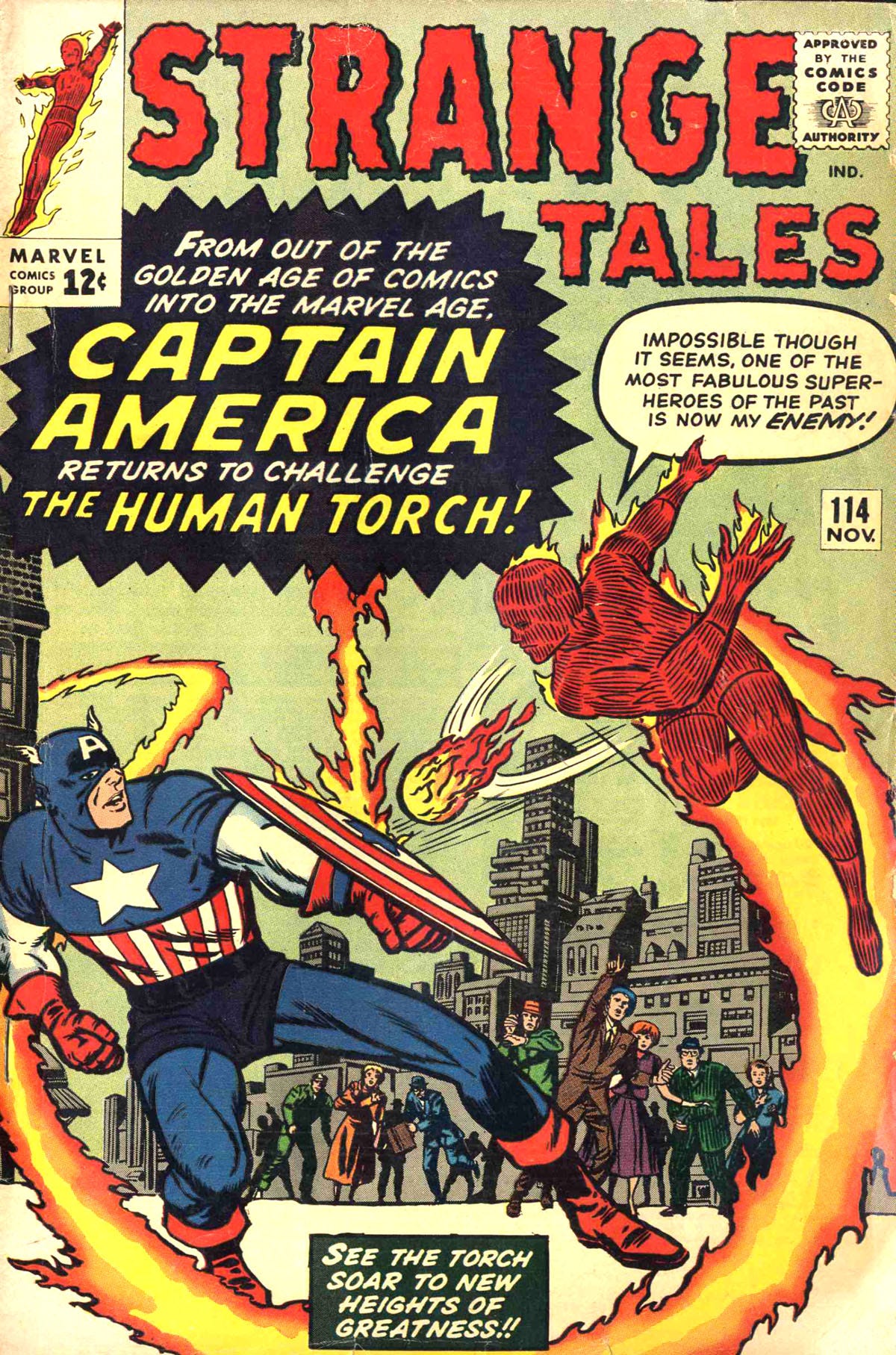
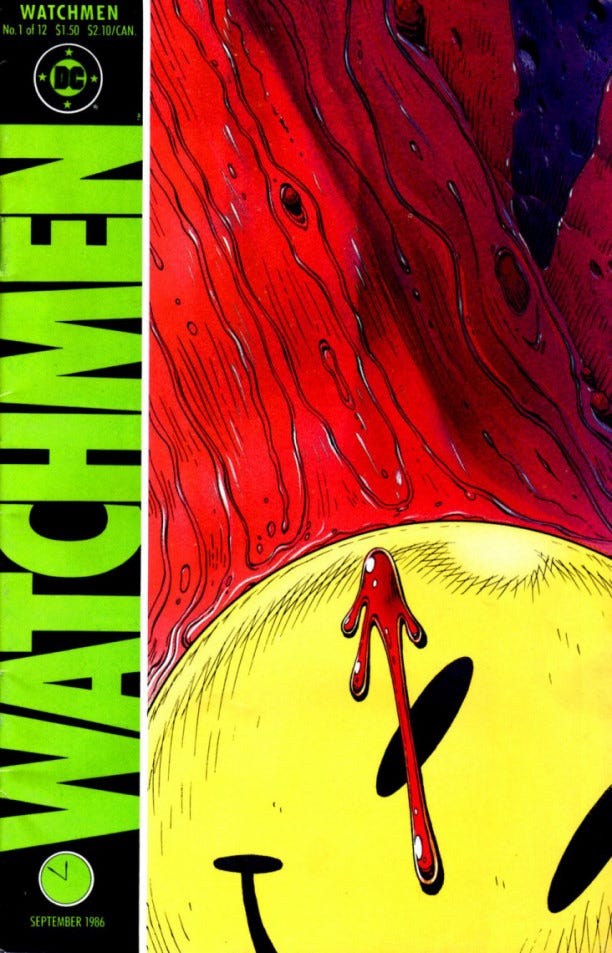
“Is anybody else even regularly doing a Substack Newsletter anymore?”
um WOW
I do give regularly to the Hero Initaitive!